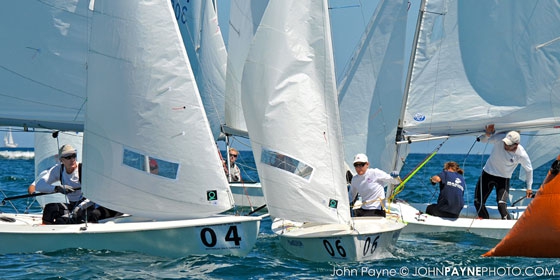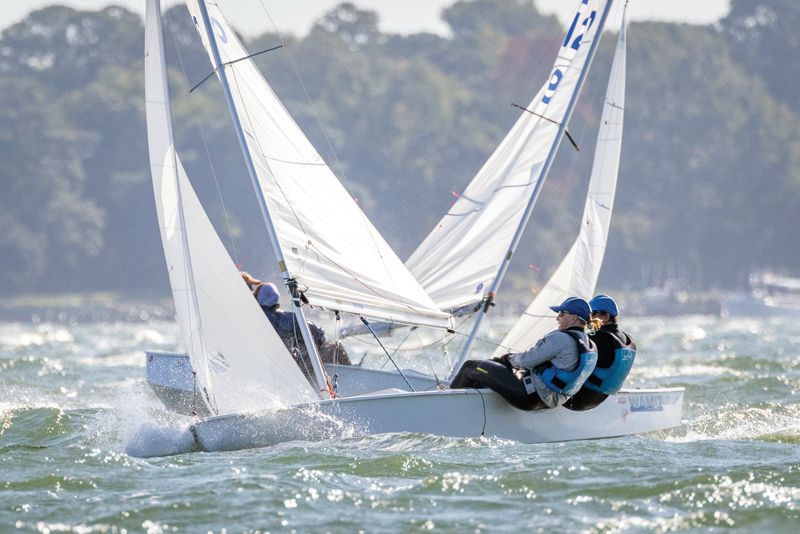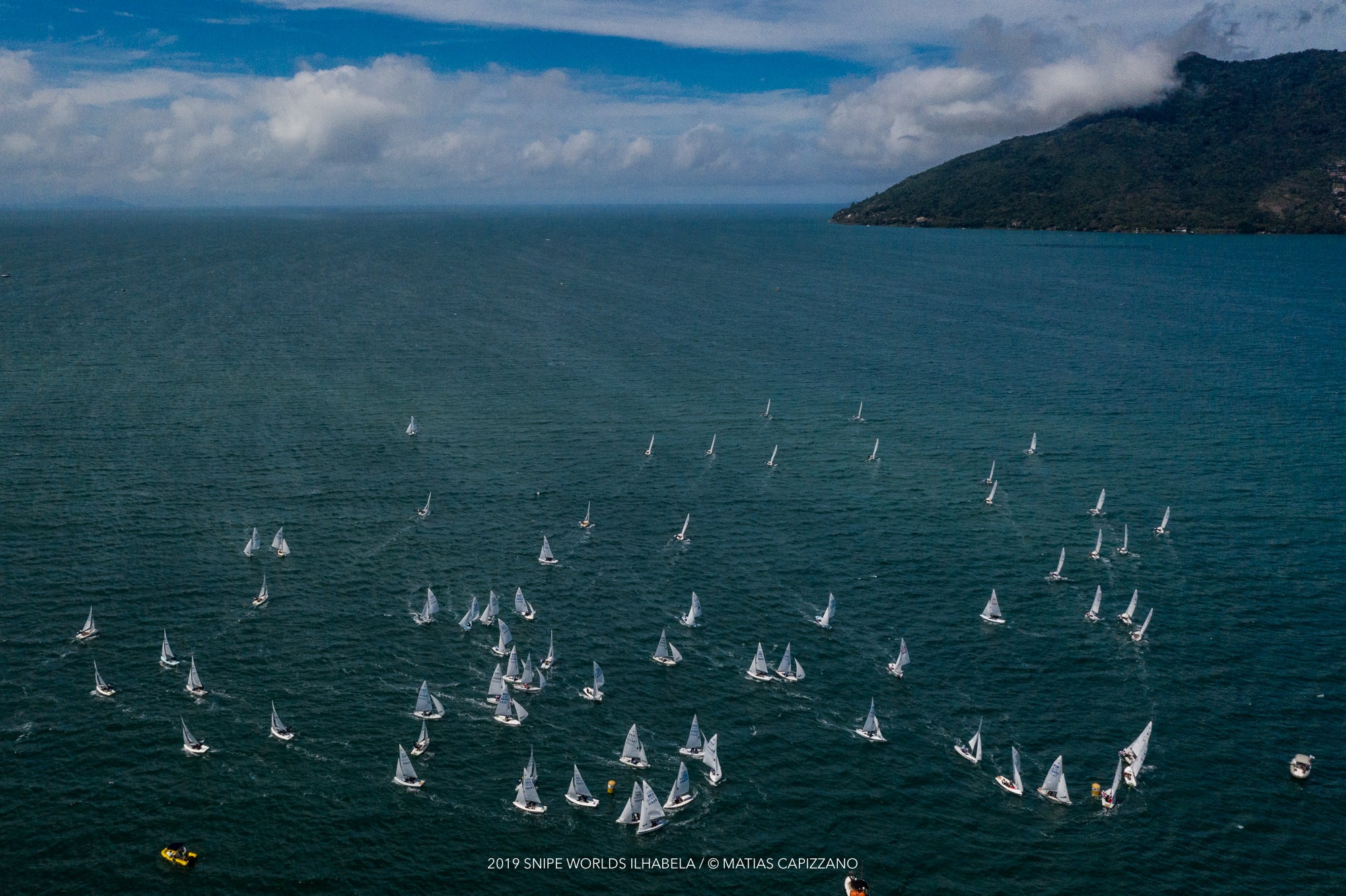Reading the Shape of the Wind
[caption id="attachment_4762" align="alignnone" width=""]Reading the wind can help you get to the mark before pileups like this one, caught by John Payne at the 2011 US Snipe Pan American Trials.[/caption] In most sports, the field of play is extremely predictable. Tennis serves are made from a baseline that is exactly the same distance away from the net, no matter where in the world you lift your racket. And in hurdles, a major controversy erupted at the 2000 Summer Olympic Games when the height of the horse was set incorrectly by mere inches. The field of play in sailing is never consistent, even from one minute to the next. We usually blame that on variations in wind strength and direction, but there’s another more subtle factor: the shape of that wind. Wind has different causes, so it fills in different shapes—lines, circles, swirls, and every possible combination of those three. Fortunately for sailors, most puffs follow the same pattern on a given racecourse for a given weather pattern, making it possible to apply the lessons learned from one puff to the next. And regardless of the wind’s shape, the goal remains the same—stay in the best pressure.


In most sports, the field of play is extremely predictable. Tennis serves are made from a baseline that is exactly the same distance away from the net, no matter where in the world you lift your racket. And in hurdles, a major controversy erupted at the 2000 Summer Olympic Games when the height of the horse was set incorrectly by mere inches.
The field of play in sailing is never consistent, even from one minute to the next. We usually blame that on variations in wind strength and direction, but there’s another more subtle factor: the shape of that wind.
Wind has different causes, so it fills in different shapes—lines, circles, swirls, and every possible combination of those three. Fortunately for sailors, most puffs follow the same pattern on a given racecourse for a given weather pattern, making it possible to apply the lessons learned from one puff to the next. And regardless of the wind’s shape, the goal remains the same—stay in the best pressure.
Helicopter Puffs
These are the most fascinating wind shapes since you can clearly see their entire perimeter from just a few feet off the water. Helicopter puffs are usually fairly random in their location and frequency. As escapees from a different breeze aloft, helicopter puffs will spread out as they hit the surface as if they were actually spun off a rotor. This instability means two things: 1) the puff won’t travel very far down the course, and 2) the breeze angles will change drastically within the puff. You are most likely to find the best pressure, and often a lift, right along the edges. So it makes sense to tack before a helicopter puff arrives, to place your boat directly to leeward of the middle of the puff.
The size and shape of these puffs will vary widely, and how large they are will affect how you play them. If the puffs are very short-lived, it’s best to wait until you find a big one. If the duration of each puff is more than a minute, connect the dots by using each puff to get you to the next one.
Helicopter puffs are usually fairly random in their appearance. From the starting area looking up the course, these puffs will often appear as a large area of wind, and it isn’t until you see them up close that they separate into their distinct forms. Keep in mind where they come from (aloft) and try to correlate any change in cloud cover with their frequency; that will help you predict their next occurrence.
Downwind, it will be very important to keep an eye over your shoulder and alter course fairly drastically to line up with the next big helicopter puff. Remember the edges of these puffs have the best pressure. And don’t jibe unless you are lining up for the next one, even if you are lifted along the edges. The bigger the pressure, the harder it will be to get through the holes in between.
Wind Lines
Have you ever watched a sea breeze fill in? To me it is the most amazing example of how quickly the water surface changes character, from a glassy golden shimmer to solid dark blue ripples the instant the breeze fills. Although sea breeze comes in as a “line,” this line is usually not quite perpendicular to the direction of travel. Often there are fingers of breeze that lead the way, unstable compared to the solid fill to come but still a big step up in velocity from the flat calm they are replacing.
A sea breeze is the most obvious example of a wind line, but most wind lines follow this basic pattern. Wind lines are usually caused by geography, so a little local knowledge can help you identify the direction and time that one will fill.
The most subtle wind lines I’ve ever seen are in Biscayne Bay in Miami. There a series of lines will fill from one side (left or right depending on the breeze direction), and the velocity change will only be one or two knots; but those that find a way to stay in the better pressure will always have a significant lead around the weather mark.
Usually the breeze is very unstable along the leading edge of a wind line, so it is best to dig into it even if it is a tempting header. Often those sailors that tack along the first edge will fall out of the breeze, while those that are a bit more patient will remain lifted, in slightly more pressure, once they finally tack.
Downwind, wind lines can be very frustrating since they fill to the back of the fleet first. It is important to pick a side and to sail the same angle as the boats behind so that you get the wind as soon as it fills down the course. It is also important to keep an eye astern to stay in the best pressure and the best lane.
Swirls
I call these “squirrelly puffs” since they don’t fill along any particular (or predictable) path. Often a puff that looks headed right for you will veer off and suddenly drop astern, just like a windblown seagull. And some will actually jump over the top of your sailplan and continue on downwind, leaving you braced for nothing. This wind shape forecasts unstable weather.
When dealing with swirls you must be able to shift gears quickly, so they don’t blow you over when they hit. Staying in the velocity is important, but you must keep the boat going fast through the sometimes radical and sudden changes in pressure and angle.
Downwind, the crew should keep an eye astern to warn of potential knockdowns or opportunities to make gains by accelerating in the swirl. And don’t be too critical of anyone calling the breeze in these conditions until you have tried it yourself!
Steady Wind
This is the easiest wind form to sail in, but it is also the one that offers the fewest opportunities. In these conditions, the biggest priorities (both upwind and downwind) are to sail in clear air and to stick to the basics—set the boat up well for the conditions, get off the line and around the marks cleanly, and keep the bow headed toward the mark.
Because wind shape usually stays the same for a given racecourse and weather pattern, you can learn from each puff and try to apply that lesson to the next one. Use the gain or loss on your competition to gauge your success, and enjoy the process! Reading the shape of the wind is one of the many great challenges of sailboat racing, and practice will only make you better.
Leave a reply
Your email address will not be published. Your comment will be revised by the site if needed.






0 comments